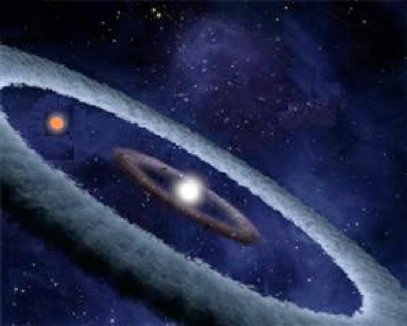FS CMa stars/B[e]
in collaboration with
Dr. A. Miroshnichenko

FS CMa stars/B[e]
in collaboration with
Dr. A. Miroshnichenko
The B[e] phenomenon was discovered by Allen & Swings (1976) in B-type stars that display forbidden (e.g., [O I], [Fe II], and [N II]) and permitted emission lines (e.g., HI and Fe II) along with large IR excesses due to CS dust. Lamers et al. (1998) recognized four subgroups of B[e] objects with known evolutionary status, namely: pre-main-sequence Herbig Ae/Be stars, symbiotic binaries (a cool giant and a white dwarf/neutron star), compact Planetary Nebulae, and supergiants. They confirmed the discoverers' suggestion that the B[e] phenomenon is found in objects at very different evolutionary stages, but with similar conditions in their CS envelopes. However, they were unable to classify ~50% of the originally selected 65 Galactic objects. Mostly double-peaked permitted optically-thick lines in objects of all B[e] subgroups indicate that CS gas is non-spherically distributed (e.g., Zickgraf 2003). Optically-thin forbidden lines form in low-density outer parts of the gaseous disk. Their presence suggests that the disks are larger than those of Be stars, which lack forbidden lines and have typical disk sizes of ~20-30 stellar radii (e.g., Bjorkman et al. 2002). The origin of CS dust is well understood in young stars which inherit it from ambient molecular clouds. Evolved cool (Teff ~3000 K) stars have strong winds and allow dust sublimation (at 1500- 2000 K) near the stellar surface, at high CS density (Gail & Seldmayr 1986). Dust forms near cool giants in symbiotic binaries.
In Planetary Nebulae it is left from the previous, AGB evolutionary stage. Evolved hot (Teff ~10000 K), massive (>= 30-40 Msun) and luminous (log L/L_sun> 5) stars with extremely dense radiation-driven winds, such as Wolf-Rayet, Luminous Blue Variables, and supergiants with the B[e] phenomenon, can also form dust due to the presence of already produced heavy elements and self-shielding of the wind parts (e.g., in clumps) from dust-destroying UV radiation (Bjorkman 1998; Kraus & Lamers 2003; Cure, Rial, & Cidale 2005). Comparing what is known about the above mentioned objects, one can conclude that nature and evolutionary status as well as the CS matter formation mechanisms are the least understood in the unclassified objects with the B[e] phenomenon. The FSCMa group consists of ~30 original unclassified objects and ~70 others found or first studied by our collaboration.
